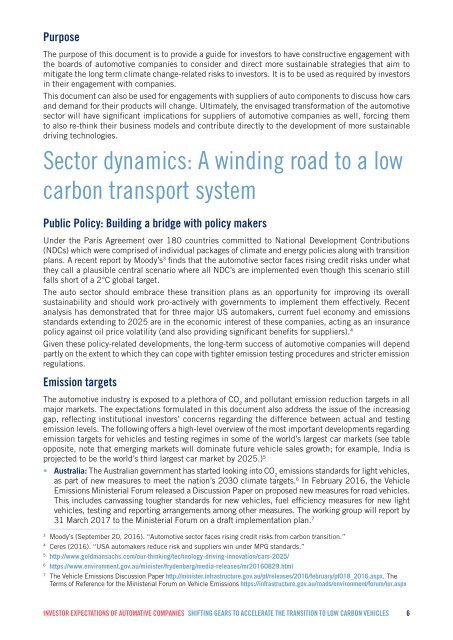INVESTOR EXPECTATIONS OF AUTOMOTIVE COMPANIES
2e2wDxT
2e2wDxT
You also want an ePaper? Increase the reach of your titles
YUMPU automatically turns print PDFs into web optimized ePapers that Google loves.
Purpose<br />
The purpose of this document is to provide a guide for investors to have constructive engagement with<br />
the boards of automotive companies to consider and direct more sustainable strategies that aim to<br />
mitigate the long term climate change-related risks to investors. It is to be used as required by investors<br />
in their engagement with companies.<br />
This document can also be used for engagements with suppliers of auto components to discuss how cars<br />
and demand for their products will change. Ultimately, the envisaged transformation of the automotive<br />
sector will have significant implications for suppliers of automotive companies as well, forcing them<br />
to also re-think their business models and contribute directly to the development of more sustainable<br />
driving technologies.<br />
Sector dynamics: A winding road to a low<br />
carbon transport system<br />
Public Policy: Building a bridge with policy makers<br />
Under the Paris Agreement over 180 countries committed to National Development Contributions<br />
(NDCs) which were comprised of individual packages of climate and energy policies along with transition<br />
plans. A recent report by Moody’s 3 finds that the automotive sector faces rising credit risks under what<br />
they call a plausible central scenario where all NDC’s are implemented even though this scenario still<br />
falls short of a 2°C global target.<br />
The auto sector should embrace these transition plans as an opportunity for improving its overall<br />
sustainability and should work pro-actively with governments to implement them effectively. Recent<br />
analysis has demonstrated that for three major US automakers, current fuel economy and emissions<br />
standards extending to 2025 are in the economic interest of these companies, acting as an insurance<br />
policy against oil price volatility (and also providing significant benefits for suppliers). 4<br />
Given these policy-related developments, the long-term success of automotive companies will depend<br />
partly on the extent to which they can cope with tighter emission testing procedures and stricter emission<br />
regulations.<br />
Emission targets<br />
The automotive industry is exposed to a plethora of CO 2<br />
and pollutant emission reduction targets in all<br />
major markets. The expectations formulated in this document also address the issue of the increasing<br />
gap, reflecting institutional investors’ concerns regarding the difference between actual and testing<br />
emission levels. The following offers a high-level overview of the most important developments regarding<br />
emission targets for vehicles and testing regimes in some of the world’s largest car markets (see table<br />
opposite, note that emerging markets will dominate future vehicle sales growth; for example, India is<br />
projected to be the world’s third largest car market by 2025.) 5<br />
• Australia: The Australian government has started looking into CO 2<br />
emissions standards for light vehicles,<br />
as part of new measures to meet the nation’s 2030 climate targets. 6 In February 2016, the Vehicle<br />
Emissions Ministerial Forum released a Discussion Paper on proposed new measures for road vehicles.<br />
This includes canvassing tougher standards for new vehicles, fuel efficiency measures for new light<br />
vehicles, testing and reporting arrangements among other measures. The working group will report by<br />
31 March 2017 to the Ministerial Forum on a draft implementation plan. 7<br />
3<br />
Moody’s (September 20, 2016). “Automotive sector faces rising credit risks from carbon transition.”<br />
4<br />
Ceres (2016). “USA automakers reduce risk and suppliers win under MPG standards.”<br />
5<br />
http://www.goldmansachs.com/our-thinking/technology-driving-innovation/cars-2025/<br />
6<br />
https://www.environment.gov.au/minister/frydenberg/media-releases/mr20160829.html<br />
7<br />
The Vehicle Emissions Discussion Paper http://minister.infrastructure.gov.au/pf/releases/2016/february/pf018_2016.aspx. The<br />
Terms of Reference for the Ministerial Forum on Vehicle Emissions https://infrastructure.gov.au/roads/environment/forum/tor.aspx<br />
<strong>INVESTOR</strong> <strong>EXPECTATIONS</strong> <strong>OF</strong> AUTOMATIVE <strong>COMPANIES</strong> SHIFTING GEARS TO ACCELERATE THE TRANSITION TO LOW CARBON VEHICLES<br />
6


